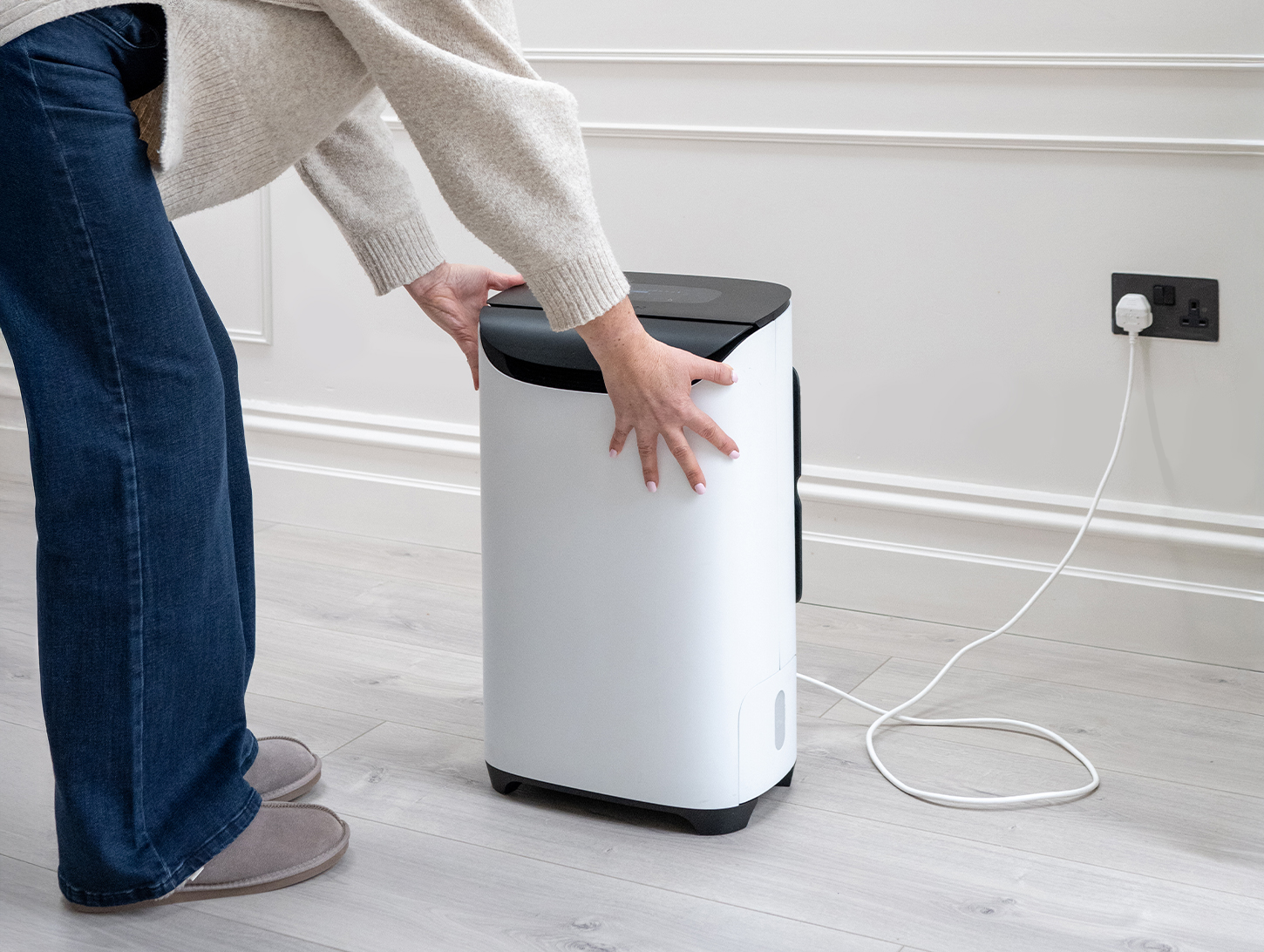Looking for a solution to damp or mould in your home? This article will help you to find out how to choose a dehumidifier – a cost-effective and instant-results solution for homes that suffer from excess moisture, humid air and damp or mould problems.
What is a dehumidifier?
The first thing you need is just a brief background on what a dehumidifier does. This will help you to choose the best type of dehumidifier for your home and your lifestyle.
Dehumidifiers are designed to remove moisture from the air. There are two types of dehumidifier: Refrigerant dehumidifiers and dessicant dehumidifiers. The most common types are refrigerant or condenser dehumidifiers. These draw in air which then passes over cold coils. When the air touches the coils, the excessive moisture in the air condenses and the water droplets fall into a built-in water tank. You can also buy drainage dehumidifiers, where you can attach a drainage pipe to the dehumidifier and put it in a sink or drain so that you can keep the unit running without needing to empty a tank.
A good quality dehumidifier can remove litres of moisture from the air in your home every day. It costs less than £3* a day to run in most circumstances, and modern designs mean you can put a unit in any room in your home without worrying about how it looks or how much noise it makes.

Our top tips for how to choose a dehumidifier for your home
Based on our experience and the feedback from thousands of customers, we’ve put together a handy guide to help you pick the best dehumidifier for your needs. If you have any questions or concerns, we’re always here to help you make a decision – just contact us on 01483 234900.
Tip #1 – Know why you need a dehumidifier
There are quick a few ways you can remove moisture from the air in your home before you invest in a dehumidifier. Often, this moisture occurs because there is inadequate ventilation in your home. So make sure you use extractor fans in your bathroom and kitchen, open windows to let humid air out, avoid drying washing indoors if you can, and check that appliances like showers, washing machines and tumble dryers are draining properly.
Tip #2 – Decide which type of dehumidifier you need
As we said above, there are two main types of dehumidifier. The refrigerant dehumidifier is the most commonly used, but homeowners do also choose the dessicant version, which passes the air over material, which absorbs the moisture. Dessicant dehumidifiers are often chosen by people who have cooler homes, so need less moisture removing from the air. They are also often quieter because they don’t have the cold coil operation. If your home is warm and you have problems with condensation and mould, we would recommend a refrigerant model.
Tip #3 – What size dehumidifier can you afford?
Dehumidifiers are cheaper than you think to buy and run. Prices usually depend on the size of the dehumidifier, and that is driven by how much water it can extract over a given period of time. Dehumidifiers come with different sized water tanks, suitable for a variety of sizes of rooms in your home. For example, the Meaco home dehumidifier range starts at an eight litre water tank, rising to a 25 litre tank. This gives homeowners plenty of choice in terms of size and budget.
Tip #4 – Portable or fixed dehumidifiers?
If you have problems with humidity levels in a particular room in your home, you may want a larger unit that sits in that one room. If, however, your home suffers from high humidity in general, you should choose a portable dehumidifier that’s easy to move from room to room. Make sure you look at the portability of the dehumidifiers you consider so that you can make the most of your investment.
Tip #5 – Must-have dehumidifier features
Do you want a timer on your dehumidifier? Would it be helpful to have a unit that turns off automatically so that it is energy efficient? Do you want to set target humidity levels so that your unit is working hard for you? Take the time to check the various features available on the types of dehumidifier you are considering so that it can do all the things you need it to.
Tip #6 – Does the dehumidifier improve air quality?
Some dehumidifiers include HEPA filters which help to purify the air. This is particularly important if you have anyone in your home who suffers from allergies or is prone to asthma. Check if the dehumidifier you are considering also improves the air quality in your home.
Tip #6 – Can the dehumidifier remove dust mites?
Dust mites are a problem in many homes, living in fabrics, carpets and bedding and often causing allergy and breathing problems. Modern dehumidifiers are designed to help remove dust mites from your home, helping to improve the health of you and your family.
Making the best choice for your home
Depending on the square footage of your home, you can choose a compact or slightly more heavyweight dehumidifer to help rid your home of excessive moisture, reduce damp and prevent mould. For example, our 25 litre Ultra Low Energy dehumidifier is designed to work in a variety of conditions – from five-bedroom houses to commercial operations. In a flat or smaller space, it’s actually more economic than a tumble dryer for handling your washing.

When you’re choosing your dehumidifier, do think about the size of your rooms and the size of your home. Consider how much you suffer from high humidity, and think about how energy efficient you need the dehumidifier to be. All these variables will help you to decide on the best model for your home.
And we are always here to help – there’s plenty of advice and reviews on our dehumidifier pages, and you can contact us on 01483 234900 with any questions that you have.
*Accurate as of October 2022 from Energy Saving Trust
Products featured: 25 litre Ultra Low Energy dehumidifier ,Meaco home dehumidifier range







12 responses
I have an integral conservatory which h is part of the kitchen and back door to garden.
I am looking fir a dehumidifier which will ve suitable to remove condensation and stop mould which gathers round the frames.
I would also like it to be able to use for laundry drying and remove odours.i have 2 cats.
Must be economical to run also.
Agnes,
Thank you for your message! To effectively remove odours, you’ll need a charcoal filter. These filters are specifically compatible with our Meaco Arete models, so if you’re looking for a unit that addresses both condensation and odours, an Arete dehumidifier would be a great choice. For the size of the unit, if you check the product specifications for each Arete model, you’ll find the suitable property size it can cover. This will help you choose the right model for your conservatory and the rest of your space.
The Arete range works best in spaces above 10°C and is designed to be very efficient to run, so it’s great for keeping energy costs low while still providing effective moisture removal. If you’re drying laundry, the Arete models also have excellent extraction rates and a dedicated laundry function, which should meet your needs for both moisture and odour removal, particularly with the charcoal filter in place.
Let us know if you need any further guidance!
Kind regards,
Omar@Meaco.
I am wondering which dehumidifier is best to put in my bedroom which is over my garage. In winter, due to the freezing cold garage and the warm bedroom, the amount of condensation is huge and this is causing mould on my walls. Please advise which is best. Thanks
Zoe,
Thank you for your enquiry regarding dehumidifiers.
Bedrooms are only small spaces and therefore you do not need a dehumidifier that is too large. You also do not want a bulky dehumidifier that will take up too much space, for example, our Arete® range can be placed against the wall, leaving you room to pass in your room. We recommend a 10L dehumidifier for bedroom, permitting your room is warm and doesn’t fall below 12°c, if however your room does frequently get cold, consider a unit with a heater inside that will also heat your space, consider any of our DD8L range.
Hope that helps,
Omar@Meaco.
Hello.
Please could you explain why having g higher humidity requires a dehumidifier with a larger tank size.
I would assume tank size just dictates how often it needs emptying.
I also assume from what I have read a dehumidifier has a maximum amount of moisture it can draw in one day, that is smaller than the tank size.
However my assu.ptions see. To be wrong based in the above comments! Any info/explanations gratefully recieved
Thanks very much.
Rachel,
Thank you for your enquiry. Higher humidity levels would generally require a powerful enough unit to tackle the humidity problem. Larger units use larger fans, thus circulating more air and capable of extracting more moisture than a unit with a smaller fan. Being larger units, bigger dimensions also allow for a larger water tank. The ability to extract refers to the number listed against a dehumidifier e.g. an a MeacoDry Arete® One 10L Dehumidifier / Air Purifier can extract 10L given the conditions are as 30 °C and 80 % RH 10.42 litres per day.
Feel free to give us a call and discuss further by phone.
Kind regards,
Omar@Meaco.
Hello, we have a three bedroom flat on one level with mould growth in two bedrooms as well as the living room at the other end of the property. As well as sorting out the condensation problem we need to be able to dry laundry daily with young kids. The newer part of the flat is quite warm and the older part is cold… Which dehumidifier do you suggest please? Thanks
Hello Kay,
Thank you for your enquiry. The apparent mould growth indicates a high humidity level, therefore to tackle this adequately use a 20L.
I would recommend using the MeacoDry Arete® One 20L Dehumidifier / Air Purifier:
https://www.meaco.com/products/meacodry-arete-one-20l-dehumidifier-and-air-purifier
It our latest dehumidifier offering a 5 year warranty, with improved features making it easier to live with in our homes. Some steps below on how to use:
– Situate your dehumidifier in a central area (e.g. a landing or hallway)
– Keep your dehumidifier running 24/7
– Keep all internal doors open
– Keep external doors and windows closed
– Insert a H13 HEPA filter to purify the air
Any questions please give us a call.
Kind regards,
Omar.
Our two bed terraced house is growing mould in the front room (on the ceiling above the window and around the window sill/frame) as well as in the two bedrooms on the external walls and windows. Plus the bathroom! We need to clean it down but also get a dehumidifier that we can move from room to room. Ideally one that is energy efficient. What can you recommend please?
Liz,
Thank you for your enquiry, usually a 12L would suffice, though for your your scenario you have the high levels of humidity evident from the growth of mold.
For this reason use a 20L such as the one below:
https://www.meaco.com/products/meacodry-arete-one-20l-dehumidifier-and-air-purifier
Energy efficient and quiet, costing approximately 6p per hour to run, have a look at the link and click on the technical overview tab on the page for more information.
I hope this helps, if I can assist with anything else, please contact us,
Omar@Meaco.
Hi
I have problems with two bedrooms in my house ( house has 5 bedrooms) with mould at the top of the ceilings. Therefore I was thinking of buying a humidifier that I move between the rooms. Which would you recommend?
Rob
Thank you for your enquiry.
With 5 bedrooms and mould already apparent, no doubt you should be using our largest capacity, MeacoDry Arete® One 25L Dehumidifier / Air Purifier.
You can read more about this product by clicking the link below, stock available nearer to the end of this month.
https://www.meaco.com/products/meacodry-arete-one-25l-dehumidifier-and-air-purifier
I hope this helps,
Omar.